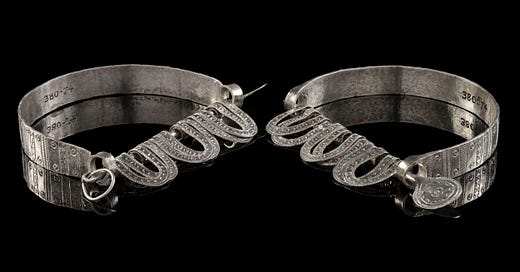Monday Cup Of Links #82 - Ancient Chariots, Muhammed Ali's warning to Indira Gandhi, Thames Torso Killer
Antenna Swords are cool.
Happy Monday!
Did you enjoy receiving two long posts last week? Do you like the frequency but prefer the posts to be shorter? I’m trying this out for size. Do respond by replying to this email, or in the comments, giving me feedback so I can better tailor it to your preferences.
Onto our links!
There’s a paper out on the Sinauli chariot excavations. The site consists of 8 burials, with three wood-and-copper chariots in them, as well as a copper coffin, and antenna swords and shields. Remains of both male and female warriors have been found, where the male warriors had shields decorated with copper and the female warriors had theirs decorated with white steatite. Archaeologists have dated this site to 2000 BCE. This is a great analysis that compares the burials to Rigvedic recommendations for burying warriors and matches the chariot with descriptions of chariots in the Mahabharata. It concludes the chariots are primitive versions of the ones described in the Kurukshetra war..
Alongside Jack The Ripper was the Thames Torso Killer. He was this lesser-known but no less ruthless serial killer who dismembered his victims and left their body parts in diverse locations. His murders were known after the first place a body part was found, like Pinchin Street or Battersea. It was hard to identify his victims, and it was also hard to pin him down to a specific neighborhood in London. Author Sarah Bax Horton, who has written a book investigating Jack The Ripper, came across the Thames Torso Killer during her research and realized that a lot of murders possibly committed by him were originally attributed to Jack The Ripper. She has a second book investigating the Thames Torso Killer and has a pretty strong candidate for who he was - James Crick, a waterman (boatman in the Thames) who was once arrested for the rape and attempted murder of a woman. One of the killings happened when he was out on bail. His job also let him move across town through the river, making him hard to pin down.
It would be interesting, I suppose, to analyze why the 60s and 70s in America and the 1880s in London were such dens of serial killing.ICYMI: I wrote a piece on Dalip Singh Saund, the first Indian-American Congressman, and his epic underdog battle to win his election while pitted against the amazing pilot, war hero, and friend of Eisenhower, Jacqueline Cochran.
Watching the elder abuse that was Mike Tyson’s match with Jake Paul, I was reminded of Muhammed Ali in his later years touring the world, and he had an interesting stop in India. He boxed in an exhibition match with Kaur Singh, who was a heavyweight champion himself. This is an interview of Kaur Singh, reminiscing about his match with Ali. But what I found most interesting was this article about Ali meeting Indira Gandhi. I found this part interesting
The exchange of pleasantries between Mrs Gandhi and Ali as well as his wife continue till suddenly Ali turns serious.Ali: I think Russia might attack you.
Mrs Gandhi: (Taken aback) I don't think so. But there is no doubt that the situation in Afghanistan is explosive, and our efforts have been to see to it that it does not spread anymore.
I suppose from the perspective of the average well-informed American during the Cold War, Russia did seem like the big bad so Ali was quite concerned for India it would seem.ICYMI: “Luxury Beliefs” has become a catchphrase now, but I don’t find too. many criticisms of the concept. I wrote a piece interrogating the concept of Luxury Beliefs and if there’s just a simpler explanation for them.
Artefact of the week: Anklets from the Asante kingdom. These were part of the royal regalia that were looted from the port of Elmina by British troops in 1874. Ghana asked for the return of these among other artefacts looted from the country. But there’s a law in the UK banning the return of artefacts in museums. The museum works around this by giving to the the Ghana government as a loan.



